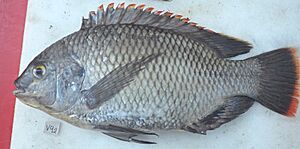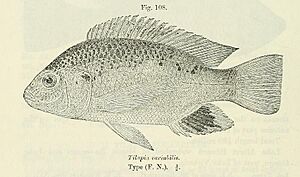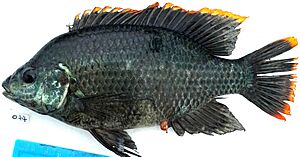Victoria tilapia facts for kids
Quick facts for kids Victoria tilapia |
|
|---|---|
 |
|
| Oreochromis variabilis, male, from Makobe Island, Lake Victoria, Tanzania, August 2016 | |
| Conservation status | |
| Scientific classification | |
| Synonyms | |
|
The Victoria tilapia, also known as Oreochromis variabilis, is a type of cichlid fish. It lives in Lake Victoria and the rivers that flow into it, called tributaries. You can also find it in Lake Kyoga, Lake Kwania, and Lake Bisina (Salisbury). It also lives in the Victoria Nile river, above Murchison Falls.
This fish can grow up to 30 centimeters (about 12 inches) long. The Victoria tilapia is important for people who fish for a living in these areas. It's also used in aquaculture, which is like farming fish. Sometimes, you can even find it in aquariums as a pet fish. Even though it's called the Victoria tilapia, it's not the only type of tilapia living in Lake Victoria. Another type, O. esculentus, also lives there and is also facing threats.
Contents
What Does the Victoria Tilapia Look Like?
The Victoria tilapia has features typical of a cichlid fish. It has a long dorsal fin (the fin on its back) with both spiny and soft parts. It also has a broken lateral line, which is a special line of sensors along its body. Like other tilapias, it has small, closely packed teeth. Young Victoria tilapias have a dark "tilapia spot" near the base of their dorsal fin.
Unique Colors and Features
One special thing about the Victoria tilapia is its color. Some fish, mostly females, have a mix of pale orange or white with dark spots. This is called polymorphism, meaning they can have different color forms. This unique pattern is why it's called variabilis, meaning "variable." Fishermen on Lake Victoria used to call these spotted fish 'Maradadi'.
Male Victoria tilapias have a distinctive look when they are ready to mate. They are usually black, sometimes with a blue-green shine. Their dorsal and tail fins have bright red edges. This fish also has a unique head shape, with a small bump just above its eyes.
How Victoria Tilapia Reproduce
Like all known Oreochromis fish, the Victoria tilapia is a mouthbrooder. This means the mother carries her eggs and young in her mouth to protect them.
Male Courtship and Nests
Male Victoria tilapias are brightly colored and gather in shallow waters. They build special nests on the muddy bottom called "bowers." These bowers are complex, with a raised central platform. This is different from other Oreochromis fish, which build simpler, saucer-shaped pits. The males aggressively defend their bowers to attract females.
Females visit several males and lay batches of eggs with different ones. They quickly pick up the eggs in their mouths. They carry the eggs for several weeks until they hatch and the young are ready to swim free. Young fish are protected in shallow, weedy or rocky areas. They can even go back into their mother's mouth if they need protection until they are about 15mm long.
In Lake Victoria, these fish usually start breeding when they are about 20 cm long. Females produce around 320 to 550 eggs, which are about 2.5 to 4.5 cm wide. The bowers built by males are quite detailed. They have a raised central saucer about 13-25 cm wide, surrounded by 6-12 smaller pits. The whole structure can be 30-90 cm wide with a raised wall around it.
Where Victoria Tilapia Live and What They Eat
In their natural home, Victoria tilapias prefer shallow areas. They like places with rocks or lots of plants. Young fish eat tiny living things called plankton. Adult fish mainly eat things from the bottom of the lake, like mud or tiny plants growing on rocks.
Current Status of Victoria Tilapia Populations
The Victoria tilapia is currently listed as "near threatened" by the IUCN (International Union for Conservation of Nature). This means their numbers are decreasing. One big reason for this decline is the introduction of Nile perch, which are large predatory fish. Other non-native tilapias were also introduced, which compete with the Victoria tilapia for food and space.
However, some populations of Victoria tilapia are still found in smaller lakes connected to Lake Victoria. These lakes have not been stocked with the new fish species. More recently, in 2016, some Victoria tilapias were found on Makobe Island, a rocky island in the Tanzanian part of Lake Victoria. This gives hope for the species' survival.




